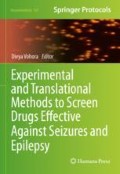Abstract
Epileptic seizures are the manifestation of several signs and/or symptoms due to heightened brain activity, causing a variety of disturbances such as motor and cognition dysfunction. In contrast, epilepsy is characterized by a chronic tendency to spawn these epileptic seizures. One way of studying epilepsy or seizures is to induce either acute seizures or epilepsy in animals via chemoconvulsants such as pentylenetetrazol (acute seizures) or kainic acid (chronic seizures), though pentylenetetrazol can also produce chronic seizures via kindling. Zebrafish are of great utility as an animal model as they have a high breeding rate and are genetically similar to humans. By intraperitoneally injecting chemoconvulsants into zebrafish, they develop seizure-like behavior, which can be scored to determine severity. By recording this behavior, the resulting locomotion pattern and parameters can also be tracked via software analysis. To investigate the cognitive decline comorbidity of epileptic seizures, mazes such as the T-maze and three-axis maze can be used to evaluate the learning and memory ability of the zebrafish via operant conditioning. This is done by comparing and contrasting the time taken for a zebrafish to reach the location of a reward over successive trials.
Access this chapter
Tax calculation will be finalised at checkout
Purchases are for personal use only
References
Fisher RS, Acevedo C, Arzimanoglou A, Bogacz A, Cross JH, Elger CE, Engel J, Forsgren L, French JA, Glynn M, Hesdorffer DC, Lee BI, Mathern GW, Moshé SL, Perucca E, Scheffer IE, Tomson T, Watanabe M, Wiebe S (2014) ILAE official report: a practical clinical definition of epilepsy. Epilepsia 55(4):475–482. https://doi.org/10.1111/epi.12550
Zaccara G, Perucca P (2015) Prevention and management of side-effects of antiepileptic drugs. In: The treatment of epilepsy. Wiley, Hoboken, pp 275–287. https://doi.org/10.1002/9781118936979.ch20
Holmes GL (2015) Cognitive impairment in epilepsy: the role of network abnormalities. Epileptic Disord 17(2):101–116. https://doi.org/10.1684/epd.2015.0739
Berghmans S, Hunt J, Roach A, Goldsmith P (2007) Zebrafish offer the potential for a primary screen to identify a wide variety of potential anticonvulsants. Epilepsy Res 75(1):18–28. https://doi.org/10.1016/j.eplepsyres.2007.03.015
Fisher RS, Boas WVE, Blume W, Elger C, Genton P, Lee P, Engel J Jr (2005) Epileptic seizures and epilepsy: definitions proposed by the International League Against Epilepsy (ILAE) and the International Bureau for Epilepsy (IBE). Epilepsia 46(4):470–472
Curia G, Longo D, Biagini G, Jones RSG, Avoli M (2008) The pilocarpine model of temporal lobe epilepsy. J Neurosci Methods 172(2):143–157. https://doi.org/10.1016/j.jneumeth.2008.04.019
Kundap UP, Paudel YN, Kumari Y, Othman I, Shaikh MF (2019) Embelin prevents seizure and associated cognitive impairments in a pentylenetetrazole-induced kindling zebrafish model. Front Pharmacol 10(315). https://doi.org/10.3389/fphar.2019.00315
Zheng X-Y, Zhang H-L, Luo Q, Zhu J (2010) Kainic acid-induced neurodegenerative model: potentials and limitations. Biomed Res Int 2011:457079
Alfaro JM, Ripoll-Gómez J, Burgos JS (2011) Kainate administered to adult zebrafish causes seizures similar to those in rodent models. Eur J Neurosci 33(7):1252–1255
Menezes FP, Rico EP, Da Silva RS (2014) Tolerance to seizure induced by kainic acid is produced in a specific period of zebrafish development. Prog Neuro-Psychopharmacol Biol Psychiatry 55:109–112
Mussulini BHM, Vizuete AFK, Braga M, Moro L, Baggio S, Santos E, Lazzarotto G, Zenki KC, Pettenuzzo L, da Rocha JBT (2018) Forebrain glutamate uptake and behavioral parameters are altered in adult zebrafish after the induction of Status Epilepticus by kainic acid. Neurotoxicology 67:305–312
Dhir A (2012) Pentylenetetrazol (PTZ) kindling model of epilepsy. Curr Protoc Neurosci 58(1):9.37.31–39.37.12
Wong K, Stewart A, Gilder T, Wu N, Frank K, Gaikwad S, Suciu C, DiLeo J, Utterback E, Chang K, Grossman L, Cachat J, Kalueff AV (2010) Modeling seizure-related behavioral and endocrine phenotypes in adult zebrafish. Brain Res 1348:209–215. https://doi.org/10.1016/j.brainres.2010.06.012
Stewart AM, Desmond D, Kyzar E, Gaikwad S, Roth A, Riehl R, Collins C, Monnig L, Green J, Kalueff AV (2012) Perspectives of zebrafish models of epilepsy: what, how and where next? Brain Res Bull 87(2):135–143
American Psychiatric Association (2013) Diagnostic and statistical manual of mental disorders (DSM-5®). American Psychiatric Pub
Goodkin K, Fernandez F, Forstein M, Miller EN, Becker JT, Douaihy A, Cubano L, Santos FH, Filho NS, Zirulnik J, Singh D (2011) A perspective on the proposal for neurocognitive disorder criteria in DSM-5 as applied to HIV-associated neurocognitive disorders. Neuropsychiatry 1(5):431–440. https://doi.org/10.2217/npy.11.57
Bailey JM, Oliveri AN, Levin ED (2015) Pharmacological analyses of learning and memory in zebrafish (Danio rerio). Pharmacol Biochem Behav 139(Pt B):103–111. https://doi.org/10.1016/j.pbb.2015.03.006
Banote RK, Koutarapu S, Chennubhotla KS, Chatti K, Kulkarni P (2013) Oral gabapentin suppresses pentylenetetrazole-induced seizure-like behavior and cephalic field potential in adult zebrafish. Epilepsy Behav 27(1):212–219
Kundap UP, Kumari Y, Othman I, Shaikh M (2017) Zebrafish as a model for epilepsy-induced cognitive dysfunction: a pharmacological, biochemical and behavioral approach. Front Pharmacol 8:515
Mussulini BHM, Leite CE, Zenki KC, Moro L, Baggio S, Rico EP, Rosemberg DB, Dias RD, Souza TM, Calcagnotto ME, Campos MM, Battastini AM, de Oliveira DL (2013) Seizures induced by pentylenetetrazole in the adult zebrafish: a detailed behavioral characterization. PLoS One 8(1):e54515. https://doi.org/10.1371/journal.pone.0054515
Author information
Authors and Affiliations
Corresponding author
Editor information
Editors and Affiliations
Rights and permissions
Copyright information
© 2021 Springer Science+Business Media, LLC, part of Springer Nature
About this protocol
Cite this protocol
Choo, B.K.M., Shaikh, M.F. (2021). Methods to Investigate Seizures and Associated Cognitive Decline Using Zebrafish Model. In: Vohora, D. (eds) Experimental and Translational Methods to Screen Drugs Effective Against Seizures and Epilepsy. Neuromethods, vol 167. Humana, New York, NY. https://doi.org/10.1007/978-1-0716-1254-5_12
Download citation
DOI: https://doi.org/10.1007/978-1-0716-1254-5_12
Published:
Publisher Name: Humana, New York, NY
Print ISBN: 978-1-0716-1253-8
Online ISBN: 978-1-0716-1254-5
eBook Packages: Springer Protocols

